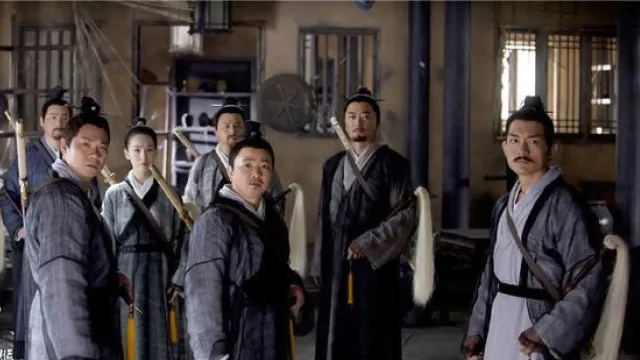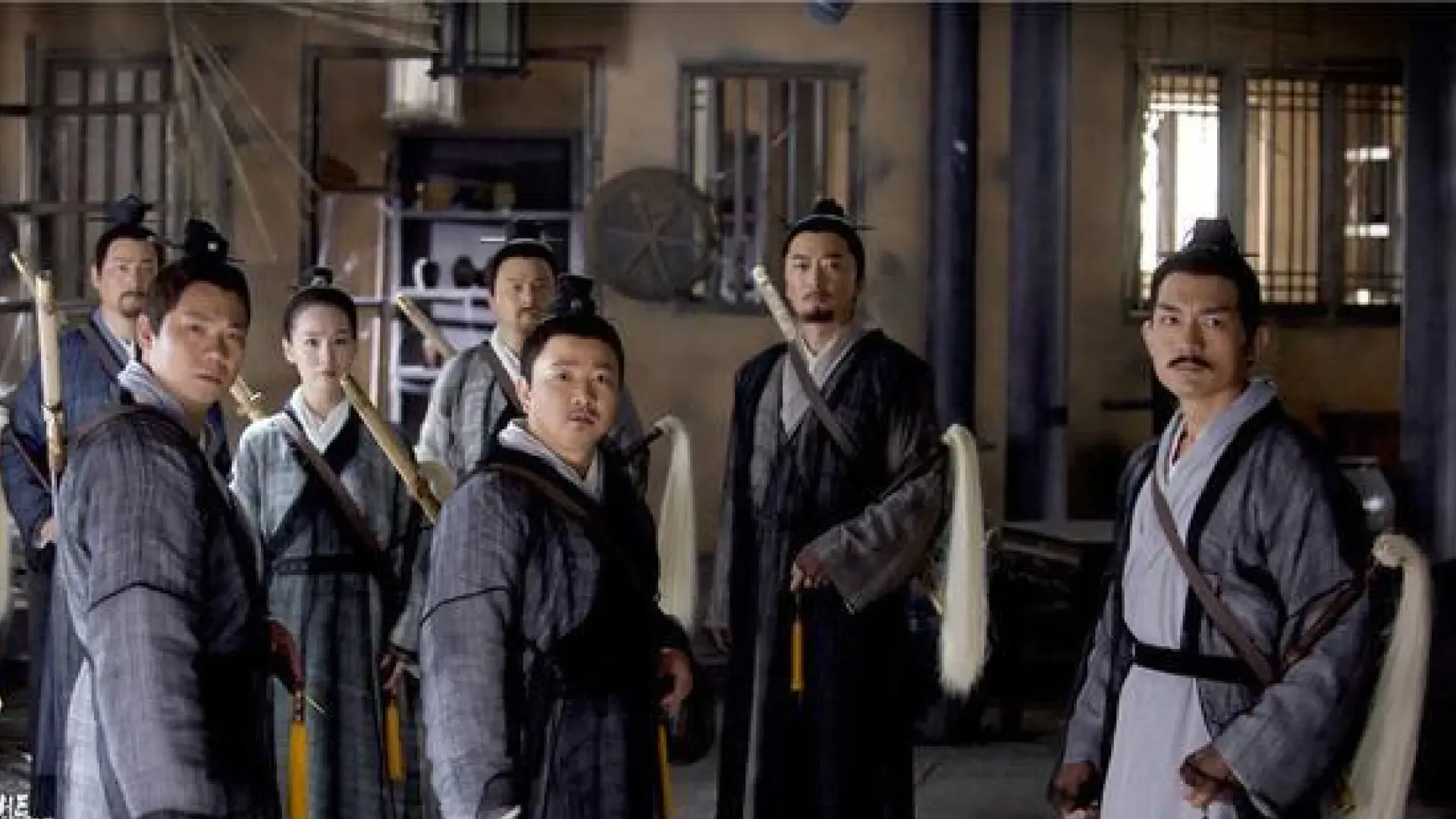Ma Yu (simplified: 马钰, traditional: 馬鈺, pinyin: Mǎ Yù, jyutping: maa5 juk6), known by his Daoist name Danyangzi,1 was the leader of the Quanzhen Order and the eldest amongst the Seven Zis of Quanzhen. As Wang Chongyang’s most trusted disciple and appointed successor, Ma Yu combined profound internal cultivation with diplomatic wisdom, ensuring the school’s stability during the turbulent transition following his shifu’s2 death.
Biography
Leadership of the Quanzhen Order
Ma Yu served as the respected leader and eldest of the Seven Masters of Quanzhen following Wang Chongyang’s death. His leadership style emphasised wisdom and diplomacy over martial prowess, making him a stabilising influence among the sometimes volatile personalities of his fellow masters.
As Wang Chongyang’s designated successor, Ma Yu inherited responsibility for maintaining the unity and moral direction of the Quanzhen Order during challenging times. His approach focused on preserving the school’s reputation for righteousness while managing the diverse temperaments and ambitions of the other Six Masters.
Secret instruction of Guo Jing
One of Ma Yu’s most significant actions occurred when he learnt of Qiu Chuji’s eighteen-year wager with the Seven Eccentrics of Jiangnan. Concerned about the implications of this competition and recognising an opportunity to guide a promising young martial artist, Ma Yu secretly travelled to the Mongolian steppes to observe Guo Jing.
Recognising Guo Jing’s earnest nature and potential for internal cultivation, Ma Yu began secretly teaching him Quanzhen breathing techniques and basic internal energy methods during midnight sessions on a cliff face. These lessons provided Guo Jing with the crucial foundation in neigong3 that he would later need to master advanced techniques from the Nine Yin Manual.
When the Seven Eccentrics discovered these secret lessons and suspected that Mei Chaofeng was teaching Guo forbidden techniques, Ma Yu revealed himself and his true purpose. His diplomatic handling of this delicate situation—explaining his motives while respecting the Eccentrics’ role as Guo Jing’s primary masters—demonstrated his characteristic wisdom and restraint.
Later challenges and diplomacy
Throughout his leadership, Ma Yu consistently worked to maintain the Quanzhen Order’s reputation while managing the more impetuous actions of his fellow masters. His measured approach to conflicts often served as a counterbalance to the more aggressive tendencies of disciples like Qiu Chuji.
Ma Yu’s diplomatic skills proved particularly valuable during various crises that threatened to embroil the Quanzhen Order in political conspiracies or factional disputes. His commitment to investigating truth rather than rushing to judgment helped preserve the school’s moral authority even when other masters favoured more direct action.
Personality and traits
Physical appearance
Ma Yu presented a dignified appearance befitting a senior Daoist master. Contemporary descriptions portrayed him as a man of average height with a calm, scholarly demeanor. Unlike some of his more physically imposing fellow disciples, Ma Yu’s presence derived from inner authority rather than physical intimidation.
His Daoist robes were always immaculately maintained, reflecting his attention to proper conduct and respect for tradition. Ma Yu typically carried a plain Daoist sword, though he rarely drew it except for formal ceremonies or when absolutely necessary for protection.
Personality and traits
Ma Yu’s most distinctive characteristic was his diplomatic temperament combined with genuine humility. He possessed natural ability to mediate between conflicting personalities and interests, often serving as a calming influence during heated disagreements among the Seven Zis. This skill proved invaluable in maintaining unity within the Quanzhen Order.
His scholarly background influenced his approach to both martial arts and leadership. Ma Yu preferred thoughtful analysis to impulsive action, often taking time to consider multiple perspectives before making important decisions. This deliberative approach sometimes frustrated more action-oriented disciples but ultimately served the school’s long-term interests.
Despite his leadership position, Ma Yu maintained remarkable humility about his abilities. He frequently acknowledged his martial limitations compared to his more combat-focused fellow disciples while quietly contributing his strengths in strategic thinking and internal cultivation.
Values and principles
Ma Yu embodied the Quanzhen Order ideal of harmonizing Confucian ethics with Daoist philosophy. He believed strongly in the principle of wu wei4 (non-action), preferring to guide through example and subtle influence rather than direct commands or confrontation.
His commitment to justice was tempered by wisdom and compassion. Ma Yu consistently sought peaceful resolutions to conflicts while maintaining clear moral standards. He viewed the Quanzhen Order’s martial abilities as tools for protecting the innocent rather than pursuing personal glory or political advantage.
The master’s approach to teaching emphasised patience and gradual development. He believed that true mastery required deep understanding of underlying principles rather than mere technical proficiency, a philosophy that influenced his instruction of both formal disciples and informal students like Guo Jing.
Martial arts abilities
Quanzhen Internal Cultivation
Ma Yu’s greatest martial achievement was his mastery of Quanzhen neigong5, the foundational practice of the Quanzhen Order. This sophisticated system of breathing techniques, meditation, and energy circulation formed the basis for all other Quanzhen martial arts.
His internal energy development was exceptionally profound, allowing him to maintain martial effectiveness despite lacking the external combat skills of his more aggressive fellow disciples. Ma Yu’s neigong provided him with remarkable endurance, healing abilities, and the power to enhance his techniques through the Big Dipper Formation.
The depth of his internal cultivation enabled Ma Yu to quickly assess and guide other practitioners. His ability to recognise Guo Jing’s potential and provide appropriate foundational training demonstrated both his technical mastery and teaching insight.
Golden Guan Jade Lock Twenty-Four Techniques
Ma Yu possessed detailed knowledge of the Golden Guan Jade Lock Twenty-Four Techniques,6 an advanced internal cultivation method that complemented the basic Quanzhen practices. These techniques involved sophisticated manipulation of internal energy through specific breathing patterns and mental visualisation.
While Ma Yu never publicly demonstrated these techniques in combat, their mastery represented the pinnacle of Quanzhen internal development. The complexity of these methods required years of dedicated practice and could only be transmitted to disciples who had already achieved considerable proficiency in basic internal cultivation.
His understanding of these advanced techniques made Ma Yu invaluable as a teacher and guide for other Quanzhen practitioners seeking to deepen their internal cultivation.
Big Dipper Formation
As one of the Seven Zis of Quanzhen, Ma Yu was instrumental in developing and perfecting the Big Dipper Formation7, the school’s signature group combat technique. This formation allowed seven practitioners to coordinate their movements and internal energy, creating a combined force far greater than the sum of their individual abilities.
Ma Yu’s role in the formation emphasised coordination and energy distribution rather than direct combat. His profound internal cultivation allowed him to serve as a stabilising force, helping to maintain the formation’s integrity during complex manoeuvres and providing energy support to other participants.
The formation’s effectiveness depended heavily on the mutual trust and understanding among the Seven Zis, qualities that Ma Yu’s diplomatic skills helped foster and maintain throughout their years of practice together.
Defensive and supportive techniques
Rather than developing spectacular offensive techniques, Ma Yu focused on defensive and supportive martial abilities that complemented his leadership role. His sword techniques emphasised precision and efficiency over flashy displays, making him a reliable partner in group combat situations.
His mastery of pressure point techniques and healing arts made him valuable as both a combatant and a support practitioner. Ma Yu could quickly treat injuries during battle and had the knowledge to counter various types of martial arts attacks through strategic pressure point manipulation.
These skills reflected his overall approach to martial arts as tools for protection and healing rather than domination or personal glory.
Relationships
Sun Buer
Ma Yu’s relationship with Sun Buer represented one of the most poignant aspects of his personal life. Their decision to abandon their marriage and become fellow disciples under Wang Chongyang required considerable personal sacrifice from both parties. Despite no longer being husband and wife, they maintained deep mutual respect and cooperation as fellow members of the Seven Zis of Quanzhen.
Their transformation from married couple to spiritual siblings illustrated the profound commitment required by the Daoist path. Both Ma Yu and Sun Bu’er successfully navigated this transition, with their continued collaboration in the Quanzhen Order serving as an example of their spiritual maturity.
Guo Jing
His relationship with Guo Jing, though informal and secret, demonstrated Ma Yu’s teaching abilities and commitment to nurturing promising young martial artists. Despite not establishing a formal master-disciple relationship, Ma Yu’s guidance provided Guo with crucial foundations that influenced his entire martial arts career.
Seven Zis of Quanzhen
Among the Seven Zis of Quanzhen, Ma Yu served as both leader and mediator. His relationship with Qiu Chuji was particularly complex, as Qiu’s aggressive temperament often created situations that required Ma Yu’s diplomatic intervention. Despite their different approaches, the two maintained mutual respect based on their shared commitment to the Quanzhen Order.
His interactions with Wang Chuyi, Liu Chuxuan, Tan Chuduan, and Hao Datong demonstrated his ability to work effectively with diverse personalities while maintaining group cohesion.
Behind the scenes
Historical figure
Ma Yu was based on the historical figure of the same name (1123-1183), who was indeed the second-generation leader of the Quanzhen Way of Daoism.8 The historical Ma Yu, born Ma Congyi, came from a wealthy family in Ninghai Prefecture9 in Shandong Province.
Known by the nickname Ma Banzhou—Ma of Half the Prefecture—due to his extensive landholdings, the historical Ma Yu was a scholar proficient in classical literature, poetry, and medical practices such as acupuncture. He married Sun Fuchun, who later became Sun Bu’er and one of the Seven Zis, and they had three sons: Tingzhen, Tingrui, and Tinggui.
In 1167, Ma Yu encountered Wang Chongyang, who had travelled east from the Zhongnan Mountains to spread Quanzhen teachings. According to historical records, Wang Chongyang employed various persuasive methods, including supernatural demonstrations and symbolic teachings, to convince Ma Yu to abandon his worldly life. Ma Yu eventually divided his wealth among his sons and, along with his wife, became Wang Chongyang’s disciple.
After Wang Chongyang’s death in 1170 at Bianliang10, modern-day Kaifeng, Ma Yu became the second-generation leader of the Quanzhen Way. In 1174, he participated in the famous four debates gathering with fellow senior disciples at Zhenwu Hall11, where each declared their spiritual focus. Ma Yu proclaimed he would “compete in poverty,” emphasising ascetic practice.
Ma Yu spent much of his leadership establishing Quanzhen foundations and conducting missionary work, including travels to Longshan12 and Huating13 regions where he converted many disciples. In 1182, Jin Dynasty policies forced him to return to Shandong. He died peacefully in 1183 at Yingxian Palace in Laiyang County14 while conducting a ritual ceremony.
Literary adaptation
Ma Yu represents Jin Yong’s adaptation of a significant historical figure for the martial arts genre, and one of the most important figures in the development of Daoist neidan15 (internal alchemy) practices. Jin Yong’s fictional version maintains the essential characteristics of scholarly wisdom, ascetic dedication, and spiritual authority while adapting the historical figure to fit the narrative needs of the Condor trilogy.
The character serves multiple literary functions in Jin Yong’s work. Through Ma Yu’s leadership challenges and diplomatic efforts, Jin Yong explores themes of institutional stability, generational transition, and the balance between individual ambition and collective responsibility. His role as a bridge between the purely spiritual and the martial aspects of Daoist practice reflects the author’s interest in the philosophical foundations underlying Chinese martial arts.
Ma Yu’s relationship with Guo Jing demonstrates Jin Yong’s belief in the importance of proper foundational training in martial arts development. The secret instruction that Ma Yu provides gives Guo the internal cultivation base necessary for later achievements, emphasising that true mastery requires both external techniques and internal development. This reflects the historical Quanzhen emphasis on neidan as the foundation for all spiritual and physical development.
The character also represents Jin Yong’s exploration of the scholarly-administrator archetype within the martial arts world. Unlike typical wuxia protagonists who achieve greatness through exceptional combat ability, Ma Yu demonstrates how wisdom, moral authority, and administrative skill can be equally important in positions of leadership and influence.
Portrayals
Ma Yu has been portrayed by numerous actors in film and television adaptations of Jin Yong’s novels:
The Legend of the Condor Heroes
- 1976 series – Tong Kam-Tong
- 1983 series – Cheung Ying Choi
- 1988 series – Huang Kuan-Hsiung
- 1994 series – Kwong Chor Fai
- 2003 series – Li Xinmin
- 2008 series – Yang Yi
- 2017 series – Wang li
- 2024 series – Wang Jiusheng
The Return of the Condor Heroes
- 1976 TV series – Tong Kam-Tong
- 1983 series – Cheung Ying Choi
- 1998 series – Yu Wenzhong
- 2006 series – Wang Weihua
Most portrayals emphasise Ma Yu’s scholarly demeanor and diplomatic nature, presenting him as a thoughtful leader whose authority derives from wisdom rather than martial prowess. Liu Dan’s portrayal in the classic 1983 adaptations is widely regarded as establishing the definitive interpretation of the character’s quiet dignity and inner strength.
See also
- The Legend of the Condor Heroes characters
- The Return of the Condor Heroes characters
- Wang Chongyang – His master
- Sun Bu’er – His former wife and fellow disciple
- Seven Zis of Quanzhen – His sworn brothers
- Quanzhen Order – His organization
- Guo Jing – His secret student
- Qiu Chuji – His martial brother
- Wang Chuyi – His martial brother
External links
Footnotes
-
丹阳子 – Dānyángzǐ. Literally cinnabar yang master. His Daoist religious name, indicating his mastery of internal alchemy practices. ↩
-
师父 – shīfū. Teacher or master responsible for technical instruction and moral guidance. Shī means teacher. Fū means father. See Wuxia Wiki. ↩
-
内功 – nèigōng. Internal cultivation. One’s ability to control and manipulate one’s own internal qi flow. See Wikipedia. ↩
-
无为 – wúwéi. Non-action or effortless action. A central Daoist principle advocating harmony with natural flow rather than forced intervention. ↩
-
全真内功 – Quánzhēn nèigōng. The complete internal cultivation method of the Quanzhen Order, combining Daoist breathing techniques with martial energy development. ↩
-
金关玉锁二十四诀 – Jīnguān Yùsuǒ Èrshísì Jué. Twenty-four advanced techniques for qi cultivation, involving precise control of energy gates and pathways within the body. ↩
-
北斗阵 – Běidǒu Zhèn. A martial formation based on the seven stars of the Big Dipper constellation, allowing coordinated attacks and mutual energy support. ↩
-
One of the two dominant denominations of Daoism. See Wikipedia. ↩
-
宁海州 – Nínghaǐ Zhōu. Prefecture in Shandong Province, modern-day Muping District of Yantai City. See Wikipedia. ↩
-
汴梁 – Biànliáng. Capital of the Northern Song Dynasty. The city was later renamed Kaifeng in the Qin dynasty. See Wikipedia. ↩
-
真武堂 – Zhēnwǔ Táng. Literally true warrior hall. ↩
-
陇山 – Lǒngshān. Southern section of Liupan Mountains in western Shaanxi and eastern Gansu provinces. The range marks the southwestern boundary of the Ordos Basin. See Wikipedia. ↩
-
华亭 – Huátíng. County in east Gansu Province. See Wikipedia. ↩
-
内丹 – nèidān. Internal alchemy. The Daoist practice of cultivating internal energy and spiritual development through meditation, breathing techniques, and mental cultivation. ↩


